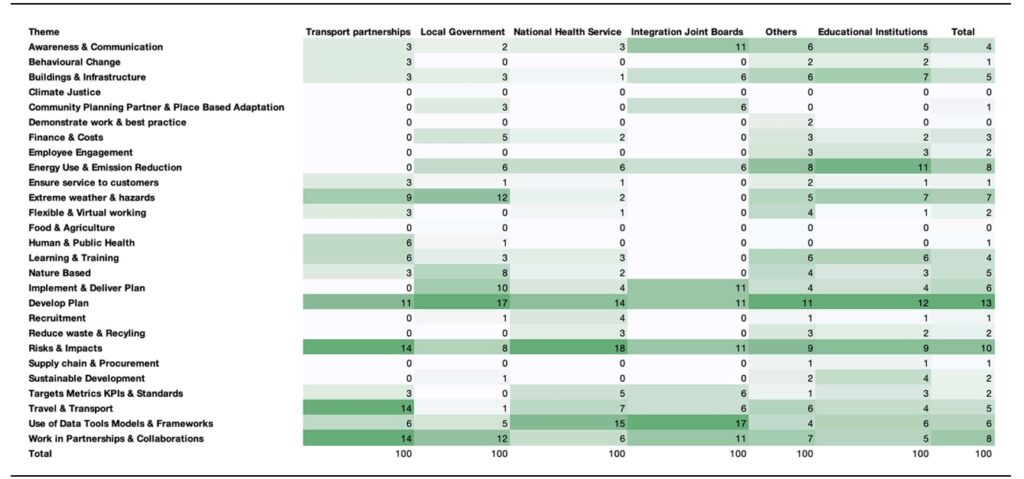The challenges of implementing adaptation actions in Scotland’s public sector

This case study is an abridged version of the original text, which can be downloaded from the right-hand column. It highlights some of the publication’s key messages below, but please access the downloadable resource for more comprehensive detail, full references, or to quote text.
Summary
This research (published in 2023) examines the progress made by the public sector in Scotland from risk assessments to adaptation planning and implementation. Highlighted are some key challenges faced by the public sector in Scotland that are leading to a lack of progress in the adaptation space as noted in a recent UK Climate Change Committee report, “Is Scotland climate ready? – 2022 Report to Scottish Parliament”.
The report highlights the lack of analysis of the adaptation section of public bodies duties reports in Scotland and our research is the first in-depth analysis of this section at time of writing supplemented by interviews with a range of public sector bodies. The key research questions considered are:
- “What tools, frameworks, data and knowledge are currently being used to conduct risk assessments for adaptation?”;
- “What kind of tools, frameworks, knowledge and data may be helpful for decision makers in this space?” and
- “What challenges and barriers exist for public sector bodies throughout their adaptation journeys?”
After first setting out the key challenges currently facing the public sector in Scotland, this report presents a range of potential solutions that could be implemented in Scotland to increase adaptation action.
Introduction
The ability to manage climate risks and adapt to climate change is becoming increasing important as the intensity and frequency of extreme weather events increase (Seneviratne et al., 2021). In Scotland, winters are becoming wetter and sea level rise around the coast has increased up to 3 cm per decade over the last 30 years (Climate Change Committee, 2022). The average temperature in Scotland has increased by 0.5 % over the same time period.
While adaptation is a key component of international climate agreements (Lee et al., 2022; United Nations / Framework Convention on Climate Change, 2015) ‘adaptation gaps’ have been identified worldwide in relation to planning, finance and implementation (Goldstein et al., 2019; United Nations Environment Programme, 2021). Scotland has to respond both to a UK and Scottish climate change policy framework mainly through the UK Climate Change Act 2008 and the Climate Change (Scotland) Act 2009. A Climate Change Risk Assessment (CCRA) is required by the UK act every five years which forms the basis of adaptation policy in the UK and in Scotland (Adaptation Scotland, 2022).
Scotland’s adaptation plan is set out in its second Scottish Climate Change Adaptation Programme (SCCAP2) (2019) which addresses the Scottish specific impacts identified in the UK CCRA. Progress towards the goals set out in SCCAP2 is independently assessed by the Climate Change Committee whose recent report ‘Is Scotland climate ready? – 2022 Report to Scottish Parliament’ highlights that Scotland’s progress in delivering its adaptation aims had stalled across most sectors and it emphasised the need to raise the level of adaptation response.
Methodology
Two adaptation questions in the Sustainable Scotland Network (SSN) Public Bodies Climate Change Reporting 2019/20 and 2020/21 reports were analysed, and then in-detail interviews were conducted with a range of individuals in the public sector who have key roles in the completion of the duties reports. The questions from the adaptation section of the reports that have been analysed are:
- Q1: ‘What are the body’s top 5 priorities for the year ahead in relation to climate change adaptation?’ and
- Q2: ‘Has the body assessed current and future climate-related risks?’.
Ten targeted interviews were conducted with representatives of public sector bodies, at differing levels of adaptation planning and risk assessment and from different geographies around Scotland. The individuals selected from public sector bodies were those who complete or have significant input into the completion of the public bodies duty reports.
Top adaptation priorities for public sector bodies
Table 2 provides a breakdown of the key themes per sector in relation to adaptation priorities from responses to Q1on top 5 priorities for the year ahead? The table highlights the most common themes across all sectors such as “Develop Plan” and “Risk & Impacts” as well as indicating sector specific recurring themes such as “Climate Justice” that only emerges from responses from Local Government for example. Two years were compared in order to understand how the adaptation priorities may change year on year since the publication of SCCAP2. Between the reporting years of 2019/20 and 2020/21 the themes discussed did not change significantly. “Develop Plan” has been the most referenced theme of these two reporting years suggesting that adaptation within the public sector in Scotland remains largely in its planning phase, a finding that aligns with the latest Climate Change Committee progress report (Climate Change Committee, 2022). When comparing the two reporting years, there are less references to “Develop Plan” in 2020 compared to 2019 and more references to “Implement & Deliver Plan” in 2020 suggesting some limited progress made between years.
Table 2. Adaptation priorities per sector (% of total number of references per theme split by sector) from Q1. Darker shaded segments relate to the higher number of references that public sector bodies made to a particular priority. Themes with the highest number of references include: developing a plan for adaptation, examining risks and impacts, using or developing relevant data sets, tools and frameworks for risk assessment or adaptation planning and working in partnership.

Enablers
Several interviewees mentioned the need for scenario methods and narrative building, participatory deliberation with local groups as well as ‘resilience’, moving from the top left to the performance‑threshold‑oriented pathway tends to be used when adaptation goals can be quantified and there is a clear, non‑contested mandate. Having embedded researchers within the public sector who could take the role of creating or interpreting local regional scenarios by way of co‑production could be a solution here. There are several organisations in Scotland that provide information, tools and knowledge to the public sector including ClimateXChange and Adaptation Scotland (Adaptation Scotland, 2022) that could fill this role for the public sector.
Key messages
This research reflects on the progress made by public sector bodies in Scotland from risk assessment to implementing adaptation actions.
The most commonly referenced theme from the analysis of the adaptation question on priorities for bodies was ‘Develop Plan’ suggesting that the public sector in Scotland is in the planning phase of adaptation. 33 % of public sector bodies are currently reporting on risks based on their response within the public bodies duties reporting however questions have arisen about how fit for purpose these risk assessments are and if undertaking a risk assessment leads to the implementation of adaptation actions. The research highlights some key challenges faced by the public sector in Scotland that could be underpinning the lack of progress made in the adaptation space.
A key theme that emerged from the analysis of the report and from interviews was the distinction between mitigation and adaptation with numerous interviewees stating that the implementation of adaptation actions is lagging behind mitigation. A key similarity between mitigation and adaptation however is that there is a current gap between planning and implementation.
Individuals within the public sector require knowledge, data and tools to complete fit for purpose risk assessments and adaptation plans. Currently, risk assessments and cost‑benefit analysis as well as expert consensus are being discussed or completed most prominently in the Scottish public sector. Collaboration is a commonly cited difference between adaptation and mitigation with adaptation involving a wider variety of stakeholders across sectors. However, siloes, both departmental and sectoral, are still acting as a barrier to adaptation. Champions for adaptation were found to be important in enabling adaptation, often driven by personal and professional motivations.
This study can help bridge the gap between climate science and decision makers by making it clearer what the requirements are for future tools, models and data to help accelerate adaptation action and how it is reported on and evaluated.
Lessons learned
This research highlights some key challenges faced by the public sector in Scotland that could be underpinning the lack of progress made in the adaptation space. A key similarity between mitigation and adaptation however is that there is a current gap between planning and implementation.
The most commonly referenced theme from public sector responses was “Develop Plan”, indicating that most bodies are in the planning phase of adaptation.
33% of public sector bodies are reporting on climate risks, but questions remain about the fitness of these risk assessments and their role in triggering adaptation actions.
A key theme was the distinction between mitigation and adaptation, with adaptation lagging behind in terms of implementation.
Differences between adaptation and mitigation arise in complexity, uncertainty, collaboration needs, and measurement frameworks.
A shared challenge for both is the gap between planning and implementation.
Connecting adaptation to other policy areas (e.g., health, education, and mitigation) could help advance action.
Developing understanding of synergies between mitigation and adaptation is key for accelerating action in Scotland and globally.
Individuals (adaptation “champions” or small teams) in the public sector face the challenge of gaining stakeholder buy-in, upskilling, and implementing actions.
This leads to capacity issues as individuals must handle both adaptation and mitigation responsibilities.
Despite being well acknowledged, key barriers such as decision-making under uncertainty, collaborative working, and skill gaps still hinder progress.
Solutions must reduce burdens on key individuals, build organisational frameworks, and address the skill gap.
Future research should explore:
- Enabling collaboration within and across public bodies.
- Understanding and measuring local capacity building and vulnerability to hazards.
- Synergies, co-benefits and trade-offs between adaptation and mitigation.
- Links to other policy areas (e.g., poverty reduction, healthcare).
- Co-producing in-context science that is quantitative, qualitative, and transdisciplinary.
Citation
Yule, E. L., Donovan, K., & Graham, J. (2023). The challenges of implementing adaptation actions in Scotland’s public sector. Climate Services, 32, 100412. https://doi.org/10.1016/j.cliser.2023.100412
Important references
C. Singh, S. Iyer, M.G. New, R. Few, B. Kuchimanchi, A.C. Segnon, D. Morchain Interrogating ‘effectiveness’ in climate change adaptation: 11 guiding principles for adaptation research and practice. Climate and Development, 14 (2022), pp. 650-664, 10.1080/17565529.2021.1964937
Emma L Yule, Kate Donovan, June Graham. ( 2023) The challenges of implementing adaptation actions in Scotland’s public sector, Climate Services, 32, ISSN 2405-8807, https://doi.org/10.1016/j.cliser.2023.100412.
Scottish Government, 2019. Climate Ready Scotland: climate change adaptation programme 2019-2024.
Adaptation Scotland, 2022. Capability Framework for a Climate Ready Public Sector.




Comments
There is no content